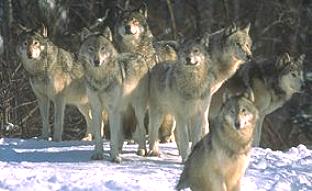Reclassification of endangered and threatened Lower 48 populations is being planned by federal officials. Some wolves are expected to lose Endangered Species Act Listing. The U.S. Fish and Wildlife Service (FWS) is in the final stage of producing a document that will have profound implications for the future of wolves in the lower 48 states. The initial product will be a proposal to reduce or remove federal protections for gray wolves south of the Canadian border. Early drafts of this proposal as well as presentations made by agency staff at professional meetings indicate that it will contain both good and bad news for wolf recovery. On the positive side, FWS appears ready to set separate recovery goals for wolves near the Great Lakes and in potential recovery areas in the Northeast. Separate recovery plans were recommended by the eastern timber wolf recovery team, composed of FWS and private scientists. The reclassification would treat northeastern wolves as a distinct population segment, allowed under the Endangered Species Act and FWS regulations. A northeastern wolf recovery plan would then have to be developed. The plan would set recovery goals and outline strategies for achieving those goals. A FWS map released two years ago indicates an intention to downlist the gray wolf from endangered to threatened status in the Northeast, Northwest, northern Rockies, southern Rockies and Southwest. Exempted from this broad-brush reclassification would be reintroduced wolves in existing recovery areas in Yellowstone National Park, central Idaho and along the Arizona-New Mexico border. Those populations will remain classified as experimental, nonessential, a special designation under the Endangered Species Act providing management flexibility to reduce wolf and livestock conflicts. California and Nevada are also important and contentious exceptions. FWS’s map shows wolves in both states as delisted or having no endangered species protections (neither state currently has any wild wolves). These are the only places in the Lower 48 where FWS proposes removing all wolf protection while not attempting to make any progress toward recovery. If wolves wander into California or Nevada, it will be legal under this arrangement to shoot them. FWS originally intended to delist Great Lakes wolves, currently listed as threatened in Minnesota and endangered in Michigan and Wisconsin. But delays in developing an acceptable Minnesota management plan prevented this. FWS reportedly will address the question of delisting later this year. Reclassification will set the stage for all future federal wolf recovery and protection efforts and thus will be an extremely important document. After it is published in the Federal Register, the public will have 120 days to urge changes in the FWS plan. For more information on this issue, visit our special online section Wolf Recovery and Reclassification. Bob Ferris is Defenders of Wildlife’s vice president for species conservation.
|
